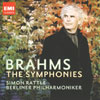Brahms Symphony No 4
Simon Rattle plunges into the Brahms symphonies with the Berlin Philharmonic
View record and artist detailsRecord and Artist Details
Composer or Director: Johannes Brahms
Genre:
Orchestral
Label: Classic
Magazine Review Date: 13/2009
Media Format: CD or Download
Media Runtime: 64
Mastering:
Stereo
DDD
Catalogue Number: CD98 593

Tracks:
| Composition | Artist Credit |
|---|---|
| Symphony No. 4 |
Johannes Brahms, Composer
Christoph Eschenbach, Conductor Johannes Brahms, Composer Schleswig-Holstein Music Festival Orchestra |
| Variations on a Theme by Haydn, 'St Antoni Chorale |
Johannes Brahms, Composer
Christoph Eschenbach, Conductor Johannes Brahms, Composer Schleswig-Holstein Music Festival Orchestra |
| (21) Hungarian Dances, Movement: G minor (orch Schmeling) |
Johannes Brahms, Composer
Christoph Eschenbach, Conductor Johannes Brahms, Composer Schleswig-Holstein Music Festival Orchestra |
Composer or Director: Johannes Brahms
Genre:
Orchestral
Label: EMI Classics
Magazine Review Date: 13/2009
Media Format: CD or Download
Media Runtime: 0
Mastering:
Stereo
DDD
Catalogue Number: 2672542

Tracks:
| Composition | Artist Credit |
|---|---|
| Symphony No. 1 |
Johannes Brahms, Composer
Berlin Philharmonic Orchestra Johannes Brahms, Composer Simon Rattle, Conductor |
| Symphony No. 2 |
Johannes Brahms, Composer
Berlin Philharmonic Orchestra Johannes Brahms, Composer Simon Rattle, Conductor |
| Symphony No. 3 |
Johannes Brahms, Composer
Berlin Philharmonic Orchestra Johannes Brahms, Composer Simon Rattle, Conductor |
| Symphony No. 4 |
Johannes Brahms, Composer
Berlin Philharmonic Orchestra Johannes Brahms, Composer Simon Rattle, Conductor |
Author: Richard Osborne
Forging a comparable discourse with the Berlin Philharmonic is no easy task, as Simon Rattle is no doubt shrewdly aware. Furtwängler had his own methods, drawing without fear or favour on the orchestra’s richly layered sound and visceral manner. A First and Third man, he highlighted the darker elements of the Second and treated the Fourth as unmitigated tragedy. Karajan, a Second and Fourth man who spent 50 years grappling with the First like a climber confronting some unattainable Alpine peak, first clarified the Berlin sound, then rebuilt it to epic proportions, as we can hear in his 1987 DG recording of the First or the tumultuous performance of that same symphony he conducted in London in October 1988 (Testament, 1/09).
During the Abbado years, it was Harnoncourt who effected the most significant change of direction with his live 1996 97 cycle. He lightened the sound, clipped the phrase lengths and revealed the pre-Classical elements in Brahms’s thinking and orchestration.
Not everything works but at its current super-budget price it is a set any interested Brahmsian should hear. After Rattle’s radically styled Vienna Philharmonic Beethoven cycle, you might imagine that his Brahms would be closer to Harnoncourt’s than Karajan’s. This is not the case. Taking on the mantle of conductor as custodian, he has gone back to the pre-1989 way of doing things. Where Harnoncourt rather underplays the First Symphony, giving it a decorous Schumannesque feel, Rattle’s reading is one in which the inwardness and charm of the exquisitely realised inner movements offset the breadth and lyric power of the surrounding drama. Less riven than Furtwängler’s reading or the later Karajan’s, it is a powerfully directed performance, measured and humane.
The EMI recording is an “in concert” affair, more closely focused, with a less natural-sounding ambience than the recording Teldec gave Harnoncourt in this same hall. Impressive in the First Symphony, it seems cloudier and more claustrophobic in the Second. Clearly the reading has something to do with this, with its bottom-heavy string sound and evened-out dynamics. I find a lack of narrative variation here; too little play of light and shade as we journey through the symphony’s changing landscapes.
We return to memorability in the Third where we hear again the kind of exquisitely quiet string- and horn-playing – the inner movements rich in beauty and quiet foreboding – which we missed in the Second. Rattle’s pacing of the first movement is almost as broad as Sanderling’s, with the exposition repeat which Sanderling omits adding to the range. Here Rattle’s finely moulded direction sustains the discourse. Tension occasionally slackens in meditative passages but this is preferable to the unnuanced approach we have in the Second Symphony.
Sadly the performance of the Fourth is again bottom-heavy, with slowish tempi that rob the music of its edge and tragic severity. As Michael Oliver observed when reviewing EMI’s Furtwängler set, “If one of a conductor’s functions is to reveal the composer’s intentions, another is to convince you that those intentions matter”. It is this latter dimension that Rattle’s Fourth currently lacks. Still, two successes out of four is not bad. In the great Brahms handicap that’s about par for the course.
As for Eschenbach’s live Tokyo Fourth, when an old friend commended the Sanderling cycle to Sir Adrian Boult, he said, “Let me hear the Tragic Overture and the finale of the Fourth”. I recalled that request as I listened to the young players of the 2005 Schleswig-Holstein Festival Orchestra vainly attempting to come to terms with the Fourth’s all-consuming finale. This is the kind of performance whose inadequacies become more apparent at each new hearing, the very last thing you want from a gramophone record.
Discover the world's largest classical music catalogue with Presto Music.

Gramophone Digital Club
- Digital Edition
- Digital Archive
- Reviews Database
- Full website access
From £8.75 / month
Subscribe
Gramophone Full Club
- Print Edition
- Digital Edition
- Digital Archive
- Reviews Database
- Full website access
From £11.00 / month
Subscribe
If you are a library, university or other organisation that would be interested in an institutional subscription to Gramophone please click here for further information.




